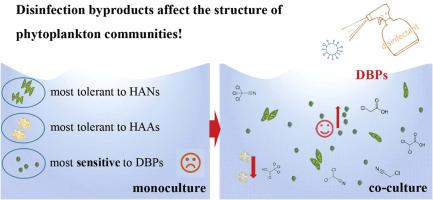Journal of Hazardous Materials ( IF 13.6 ) Pub Date : 2021-07-17 , DOI: 10.1016/j.jhazmat.2021.126679 Huijun Cui 1 , Xiaoshan Zhu 2 , Yanjie Zhu 2 , Yuxiong Huang 2 , Baiyang Chen 1

|
Intensive disinfection of wastewater during the COVID-19 pandemic might elevate the generation of toxic disinfection byproducts (DBPs), which has triggered global concerns about their ecological risks to natural aquatic ecosystems. In this study, the toxicity of 17 DBPs typically present in wastewater effluents on three representative microalgae, including Scenedesmus sp. (Chlorophyta), Microcystis aeruginosa (Cyanophyta), and Cyclotella sp. (Bacillariophyta) was investigated. The sensitivities of the three microalgae to DBPs varied greatly from species to species, indicating that DBPs may change the structure of phytoplankton communities. Later, co-cultures of these phytoplankton groups as a proxy of ecological freshwater scenario were conducted to explore the impacts of DBPs on phytoplankton community succession. M. aeruginosa became surprisingly dominant in co-cultures, representing over 50% after dosing with monochloroacetic acid (MCAA, 0.1–10 mg/L). The highest proportion of M. aeruginosa was 70.3% when exposed to 2 mg/L MCAA. Although Scenedesmus sp. dominated in monochloroacetonitrile (MCAN) exposure, M. aeruginosa accounted for no less than 30% even at 40 mg/L MCAN. In this study, DBPs disrupted the original inter-algal relationship in favor of M. aeruginosa, suggesting that DBPs may contribute to the outbreak of cyanobacterial blooms in aquatic ecosystems.
中文翻译:

DBPs对共培养系统中淡水浮游植物群落的生态毒理效应
在 COVID-19 大流行期间对废水进行强化消毒可能会增加有毒消毒副产物 (DBP) 的产生,这引发了全球对其对自然水生生态系统的生态风险的担忧。在这项研究中,废水排放物中通常存在 17 种 DBP 对三种代表性微藻(包括栅藻属)的毒性。(Chlorophyta)、Microcystis aeruginosa (Cyanophyta) 和Cyclotellasp。(Bacillariophyta) 进行了调查。三种微藻对 DBPs 的敏感性因物种而异,表明 DBPs 可能会改变浮游植物群落的结构。随后,将这些浮游植物群的共培养作为生态淡水情景的代表,以探索 DBPs 对浮游植物群落演替的影响。M. aeruginosa在共培养中出人意料地占优势,在给予一氯乙酸 (MCAA, 0.1–10 mg/L) 后占 50% 以上。当暴露于 2 mg/L MCAA 时,铜绿假单胞菌的最高比例为 70.3%。虽然Scenedesmus sp。以一氯乙腈 (MCAN) 暴露为主,绿脓杆菌即使在 40 mg/L MCAN 下也占不低于 30%。在这项研究中,DBPs 破坏了原来的藻类间关系,有利于绿脓杆菌,这表明 DBPs 可能有助于水生生态系统中蓝藻水华的爆发。



























 京公网安备 11010802027423号
京公网安备 11010802027423号